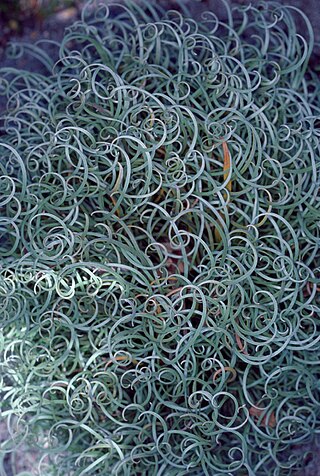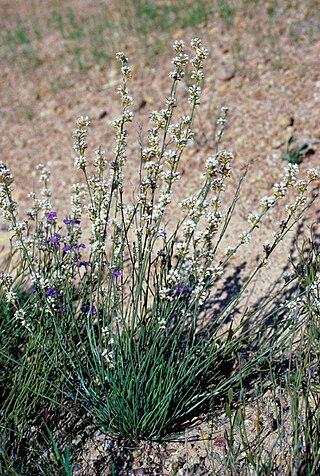
Calytrix achaeta, commonly known as the white-flowered turkey bush, kerosene wood or fringe-myrtle, is a species of flowering plant in the myrtle family Myrtaceae and is endemic to north-western Australia. It is a shrub or tree with hairy branchlets, egg-shaped, linear or lance-shaped leaves, and white to cream-coloured flowers with 12 to 18 stamens in a single row.
Leptospermopsis roei is a species of spreading shrub that is endemic to the southwest of Western Australia. It has thin, fibrous bark, long egg-shaped to narrow wedge-shaped leaves, white or pink flowers and small fruit that are shed with the seeds.

Conospermum bracteosum is a species of flowering plant in the family Proteaceae and is endemic to the south-west of Western Australia. It is an erect, spindly shrub with egg-shaped leaves, sometimes with the narrower end towards the base, and spikes of silky, woolly, tube-shaped white flowers.

Conospermum capitatum is a species of flowering plant in the family Proteaceae, and is endemic to the south-west of Western Australia. It is a low, erect shrub with coiled leaves and head-like panicles of red to pale yellow and hairy, tube-shaped flowers.

Conospermum coerulescens is a species of flowering plant in the family Proteaceae and is endemic to the south of Western Australia. It is an erect shrub with thread-like to narrowly lance-shaped leaves and spikes of up to 10 greyish-blue to deep blue, hairy flowers.

Conospermum crassinervium, commonly known as summer smokebush or tassel smokebush, is a species of flowering plant in the family Proteaceae, and is endemic to the south-west of Western Australia. It is a low, tufted shrub with clustered leaves arranged at the base of the plant and corymbs of spikes of white to grey, hairy, tube-shaped flowers.

Conospermum croniniae is a species of flowering plant in the family Proteaceae and is endemic to the south-west of Western Australia. It is an erect, open shrub with spreading cylindrical leaves and spikes of up to 6 pale blue or pink, tube-shaped, hairy flowers.

Conospermum densiflorum, commonly known as crown smokebush, is a species of flowering plant in the family Proteaceae and is endemic to the south-west of Western Australia. It is an erect, much-branched shrub with thread-like leaves at the base of the plant, and spikes or corymbs of velvety, cream-coloured or blue, tube-shaped flowers.

Conospermum eatoniae, commonly known as blue lace, is a species of flowering plant in the family Proteaceae and is endemic to the south-west of Western Australia. It is a spreading shrub with egg-shaped leaves only present on young plants, and panicles of glabrous blue, tube-shaped flowers with pale green bracteoles.

Conospermum ephedroides is a species of flowering plant in the family Proteaceae and is endemic to the south-west of Western Australia. It is a tufted shrub with many stems, a few cylindrical leaves at the base of the plant, and sessile spikes of glabrous white, pale pink or blue, tube-shaped flowers and reddish-brown to orange nuts.

Conospermum filifolium is a species of flowering plant in the family Proteaceae and is endemic to the south-west of Western Australia. It is a shrub with thread-like, S-shaped leaves, and spike-like panicles of woolly white, occasionally blue, tube-shaped flowers.

Conospermum flexuosum, commonly known as the tangled smokebush, is a species of flowering plant in the family Proteaceae and is endemic to the south-west of Western Australia. It is a sprawling shrub with many zig-zag branches, panicles of white to pale blue, tube-shaped flowers and urn-shaped, hairy nuts.

Conospermum floribundum is a species of flowering plant in the family Proteaceae and is endemic to the south of Western Australia. It is a compact, erect shrub with narrowly linear leaves that are circular in cross-section, and spike-like panicles of white, tube-shaped flowers with blue tips.

Conospermum leianthum is a species of flowering plant in the family Proteaceae and is endemic to the south-west of Western Australia. It is a shrub with thread-like leaves, and panicles of white and more or less purple, tube-shaped flowers.
Conospermum multispicatum is a species of flowering plant of the family Proteaceae and is endemic to the south-west of Western Australia. It is a dense, rounded shrub with glabrous leaves that are round in cross section, spikes of woolly hairy, white flowers and woolly hairy nuts.
Conospermum paniculatum is a species of flowering plant in the family Proteaceae and is endemic to the south-west of Western Australia. It is an erect, much-branched shrub with spoon shaped to egg-shaped leaves with the narrower end towards the base, and spikes of blue to pink, tube-shaped flowers, the fruit an urn-shaped nut.
Conospermum petiolare is a species of flowering plant in the family Proteaceae and is endemic to the south of Western Australia. It is a tufted subshrub or shrub with dense, erect, narrowly oblong leaves, and panicles of velvety cream-coloured, orange-yellow or pink, tube-shaped flowers, the fruit a hairy, brownish-yellow to gold-coloured nut.
Conospermum sigmoideum is a species of flowering plant in the family Proteaceae and is endemic to the south of Western Australia. It is an erect shrub with S-shaped leaves, circular in cross section, and spikes of 5 to 10, pale blue, tube-shaped flowers with deep blue bracteoles.

Daviesia divaricata, commonly known as marno, is a species of flowering plant in the family Fabaceae and is endemic to the south-west of Western Australia. It is a low, spreading or erect and bushy shrub with phyllodes reduced to small, triangular scales, and orange and maroon flowers.

Conospermum hookeri, commonly known as Tasmanian smokebush, is a species of flowering plant in the family Proteaceae and is endemic to Tasmania. It is a shrub with many branches, spatula-shaped or linear leaves, panicles of spikes of white, tube-shaped flowers and reddish brown nuts covered with silky fawn-coloured hairs.
















